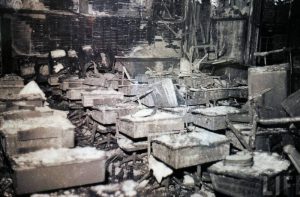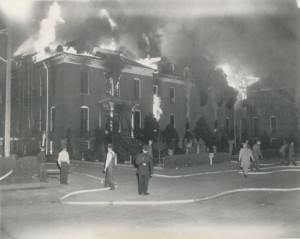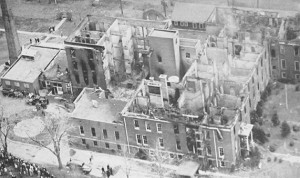nuns
 Prior to December 1, 1958, fire drills were not normal procedure, and in fact, were not held at all. No one knew how important fire drills were, even though they knew the dangers of fire, and just how deadly it was. Mainly, they did not realize just how important fire drills were to the safe evacuation of people from a burning building. Prior to that day, when there was a fire, those who knew about the fire ran, and most didn’t think about raising the alarm to let others know. This was especially true in schools, where in reality, fire drills were exponentially more important, because the drill made an emergency seem like just another drill, and could be carried out, before the smell of smoke even arrived in the rooms of the school. Prior to December 1, 1958, the schools had an alarm, but all too often, setting it off was the last thing on the minds of the people in charge…mostly due to their own panic. Later it would be determined that with practice, an emergency situation could be handled, and the people evacuated quickly, if the procedure was simply a practiced maneuver that everyone knew and automatically executed.
Prior to December 1, 1958, fire drills were not normal procedure, and in fact, were not held at all. No one knew how important fire drills were, even though they knew the dangers of fire, and just how deadly it was. Mainly, they did not realize just how important fire drills were to the safe evacuation of people from a burning building. Prior to that day, when there was a fire, those who knew about the fire ran, and most didn’t think about raising the alarm to let others know. This was especially true in schools, where in reality, fire drills were exponentially more important, because the drill made an emergency seem like just another drill, and could be carried out, before the smell of smoke even arrived in the rooms of the school. Prior to December 1, 1958, the schools had an alarm, but all too often, setting it off was the last thing on the minds of the people in charge…mostly due to their own panic. Later it would be determined that with practice, an emergency situation could be handled, and the people evacuated quickly, if the procedure was simply a practiced maneuver that everyone knew and automatically executed.
So, what led up to the fire drill revelation? Basically, it was due to a fire at a grade school in Chicago that killed 90 students on this day in 1958. Our Lady of Angels School was operated by the Sisters of Charity in Chicago. In 1958, there were well over 1,200 students enrolled at the school, which occupied a large, old building. In  those days, little was done in the way of fire prevention. The building did not have any sprinklers and no regular preparatory drills were conducted. Those two factors combined, led to disaster when a small fire broke out in a pile of trash in the basement, and quickly burned out of control.
those days, little was done in the way of fire prevention. The building did not have any sprinklers and no regular preparatory drills were conducted. Those two factors combined, led to disaster when a small fire broke out in a pile of trash in the basement, and quickly burned out of control.
It is thought that the fire began about 2:30 pm. Within minutes, several teachers on the first floor smelled it. These teachers led their classes outside, but because it was never practiced, no one thought to sound a general alarm. The school’s janitor discovered the fire at 2:42 pm, and shouted for the alarm to be rung…but by then, at least ten precious minutes had passed since the fire started. Time to evacuate was quickly running out. Unfortunately, the janitor was either not heard or the alarm system did not operate properly. The students in the classrooms on the second floor were completely unaware of the rapidly spreading flames beneath them. It took a few more minutes for the fire to reach the second floor. By this time, panic had overtaken the students and teachers. Some panic stricken students jumped out windows to escape. I can only imagine the horror the firefighters must have felt as the roll up to the scene to find students hanging from the second floor windows, as they ran to try to catch them as they fell. Although the firefighters who were arriving on the scene tried to  catch them, some were injured. Firefighters also tried to get ladders up to the windows. One quick-thinking nun had her students crawl under the smoke and roll down the stairs, where they were rescued. Other classes remained in their rooms, praying for help. There was no protocol…no routine…and for 90 students and 3 nuns, no chance of survival. Several hours later, when the fire was finally extinguished, the authorities found the 90 students and 3 nuns in the ashes of the classrooms. Sadly, it is the horrific “lessons” that trigger the quickest move to change, and this fire was no different. These days, when students hear the alarm…which is automatic when smoke is detected, they line up, and leave the school in a calm and orderly manner. Fire drills save lives.
catch them, some were injured. Firefighters also tried to get ladders up to the windows. One quick-thinking nun had her students crawl under the smoke and roll down the stairs, where they were rescued. Other classes remained in their rooms, praying for help. There was no protocol…no routine…and for 90 students and 3 nuns, no chance of survival. Several hours later, when the fire was finally extinguished, the authorities found the 90 students and 3 nuns in the ashes of the classrooms. Sadly, it is the horrific “lessons” that trigger the quickest move to change, and this fire was no different. These days, when students hear the alarm…which is automatic when smoke is detected, they line up, and leave the school in a calm and orderly manner. Fire drills save lives.
 Much has been learned over the years about fire safety and about the things that can be extremely hazardous. Unfortunately, as with most things humans learn about, this information came at a price. Just before midnight on April 4, 1949, in Effingham, Illinois, at Saint Anthony’s Hospital, a fire broke out. I can’t imagine a worse place to have a fire, than a hospital or nursing home, because not everyone can just stand up and file out of the building in a safe and orderly fashion. In addition to that, there were not as many fire safety regulations in place back then. The resulting disaster caused the death of 74 people at the hospital.
Much has been learned over the years about fire safety and about the things that can be extremely hazardous. Unfortunately, as with most things humans learn about, this information came at a price. Just before midnight on April 4, 1949, in Effingham, Illinois, at Saint Anthony’s Hospital, a fire broke out. I can’t imagine a worse place to have a fire, than a hospital or nursing home, because not everyone can just stand up and file out of the building in a safe and orderly fashion. In addition to that, there were not as many fire safety regulations in place back then. The resulting disaster caused the death of 74 people at the hospital.
This fire became the example of the special hazards that hospitals can present for a fire disaster, and it was that reason for the regulations to be updated. The safety of the patients was paramount, and something had to  be done. The hospital was operated by the Sisters of Saint Francis, who lived at the convent next door to the hospital. The was constructed mainly out of wood and brick. It housed 100 beds. Parts of the building dated back to 1876. By 1949 the facility was completely outdated. It contained open corridors and staircases. Many walls and ceilings were covered with oilcloth fabrics and combustible soundproof tiles. The building lacked sprinklers, as well as fire detection and alarm systems. Because the hospital was built of wood and brick, and much of it was an open floor plan, there was little to stop the progression of the fire. The combustible building materials gave no resistance to the advancement of the flames.
be done. The hospital was operated by the Sisters of Saint Francis, who lived at the convent next door to the hospital. The was constructed mainly out of wood and brick. It housed 100 beds. Parts of the building dated back to 1876. By 1949 the facility was completely outdated. It contained open corridors and staircases. Many walls and ceilings were covered with oilcloth fabrics and combustible soundproof tiles. The building lacked sprinklers, as well as fire detection and alarm systems. Because the hospital was built of wood and brick, and much of it was an open floor plan, there was little to stop the progression of the fire. The combustible building materials gave no resistance to the advancement of the flames.
At the time of the fire, there were 116 patients and ten staff members were on duty. Many of them were trapped on the upper floors when the fire engulfed the lower floors. This number included eleven newborn infants and the nurse who stayed behind with them. A total of 74 people died, including patients, nurses, nuns, a priest and Frank Ries, the hospital superintendent who ran into the flames to try to rescue his wife. The Effingham Volunteer Fire Department, with its 26 men and three pumpers were fighting a losing battle. They simply didn’t have the resources they needed to put out a fire of this magnitude. Eleven other fire departments  also responded. but little could be done.
also responded. but little could be done.
The cause was never determined, but investigators found many safety issues with the building. Something had to change. In response to the fire, Governor Adlai Stevenson ordered the evaluation of all the hospitals in the state to identify and mitigate fire hazards. The impact of the fire went beyond Illinois as hospitals across the United States made many of the fire protection improvements that are standard today. It is sometimes a matter of live and learn in this life, but it is very sad that it takes something as tragic as this to look into the possible fire hazards that can quickly end a life.

